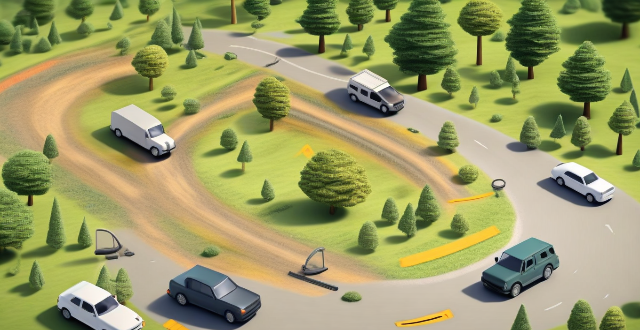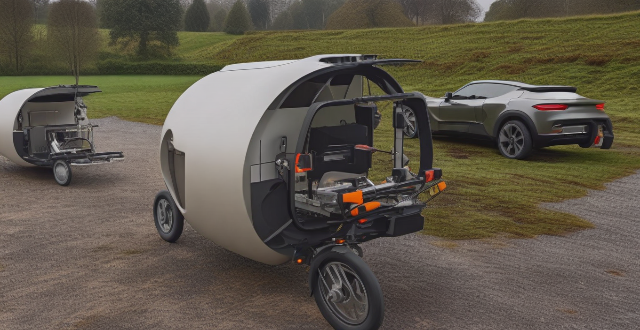Vehicle Road

How should I prepare my vehicle for a long-distance road trip ?
Preparing Your Vehicle for a Long-Distance Road Trip A long-distance road trip is an exciting adventure, but it's essential to ensure that your vehicle is in top condition before hitting the open road. Here are some steps you can take to prepare your car for the journey ahead: Check the basics such as tires, fluids, lights, and battery. Perform safety checks on brakes, suspension, belts, and hoses. Make sure your entertainment system and charging ports are working correctly. Consider installing seat covers and using organizers or storage solutions to keep items tidy and accessible during the trip. Don't forget to pack an emergency kit with jumper cables, a flashlight, reflective triangles, and a first aid kit just in case you encounter any issues along the way.

Are hub motors suitable for off-road vehicles ?
Hub motors, known for their compact design, high efficiency, and low maintenance needs, have become increasingly popular in electric vehicles. However, their suitability for off-road vehicles is a topic of debate due to several challenges. These include waterproofing concerns, potential issues with ground clearance and power output. While hub motors offer advantages such as space-saving design and direct drive power, they must be properly sealed and designed with effective cooling systems to prevent damage from harsh environments. Additionally, the addition of hub motors can reduce ground clearance, making it more difficult for off-road vehicles to navigate rough terrain. In conclusion, whether hub motors are suitable for an off-road vehicle depends on the specific needs and requirements of the application.

How can we improve road safety in our community ?
Road safety is a crucial aspect that requires collective efforts from all stakeholders. Here are some ways to enhance road safety: education and awareness, infrastructure improvements, enforcement of laws, technological advancements, community involvement, and collaboration with stakeholders. By implementing these strategies, we can create a safer environment for everyone.

What is the range of a parallel hybrid electric vehicle (PHEV) ?
The range of a parallel hybrid electric vehicle (PHEV) depends on several factors, including battery size, driving habits, road conditions, and fuel economy. Larger batteries provide longer ranges, while smaller batteries offer shorter ranges. Driving habits also play a significant role in determining the range of a PHEV. Road conditions can affect the efficiency of both the internal combustion engine and electric motor, leading to lower overall range. The combined range of a PHEV typically falls within the range of 300-600 miles, depending on the model and driving conditions.

How do hub motors affect the handling and performance of a vehicle ?
Hub motors offer numerous benefits for vehicle handling and performance, including improved weight distribution, torque vectoring, and energy recovery through regenerative braking. These features enhance a vehicle's overall efficiency, stability, and performance. As technology advances, we can expect to see more innovative uses for hub motors in the automotive industry.

How many super fast charging stations are needed to effectively support the growing number of electric vehicles on the road ?
The number of super fast charging stations needed for electric vehicles depends on factors like vehicle range, driving habits, charging speed, and network density. A rough estimate suggests one station per 50-100 vehicles, but this should be adjusted based on local conditions and specific requirements.

How do I choose the right rental car for a road trip ?
When planning a road trip, selecting the right rental car is crucial for comfort, safety, and enjoyment. Here's how to make the best choice: **Consider Your Travel Needs** - Number of Passengers: Determine how many people will be traveling with you. A compact car might suffice for two adults, but a larger group may require an SUV or minivan. - Luggage Space: Think about the amount of luggage you'll have. If you're packing heavily or bringing bulky items like sports equipment, opt for a car with ample trunk space or a hatchback. **Assess the Terrain** - City Driving: If your trip involves mostly city driving, a smaller, fuel-efficient car will be easier to navigate through traffic and park. - Rural or Mountainous Areas: For winding roads and rough terrain, consider a vehicle with better handling and ground clearance, like an SUV or an all-wheel drive vehicle. **Set Your Budget** - Fuel Economy: Check the fuel efficiency ratings of different cars. A more economical car can save you money on gas during your trip. - Rental Rates: Look at the daily or weekly rates for different types of vehicles. Higher-end models and larger vehicles typically cost more to rent. **Check for Features and Add-ons** - GPS and Navigation: Decide if you need in-car navigation. Some rentals come with built-in systems or you might use your smartphone with a mount. - Entertainment: If you'll have children on board, look for rentals that offer rear-seat entertainment systems to keep them occupied. **Safety First** - Safety Ratings: Research the safety ratings of the rental cars you're considering. Choose vehicles with high safety scores to protect you and your passengers. - Emergency Kit: Ensure the rental includes an emergency kit (e.g., spare tire, jack, jumper cables) in case of unforeseen circumstances. **Read Reviews and Ask Questions** - Customer Experience: Read reviews from previous renters to learn about their experiences with specific car models or rental companies. - Insurance Options: Understand the insurance options provided by the rental company and whether it's worth purchasing additional coverage. **Book Early for Best Deals** - Advance Reservations: The earlier you book, the more likely you are to get the car you want at a better rate. - Comparison Shop: Use comparison websites to find the best deals among various rental companies.

What are the best routes for a Canadian road trip ?
Canada is a land of diverse landscapes, from the rugged mountains to the vast coastline. A road trip across this beautiful country can be an unforgettable experience. Here are some of the best routes for a Canadian road trip: - The Trans-Canada Highway (Route 1) - The Cabot Trail, Nova Scotia - Icefields Parkway, Alberta - Dempster Highway, Yukon - Pacific Rim Highway, British Columbia

What is the current state of electric vehicle infrastructure in major cities ?
The current state of electric vehicle (EV) infrastructure in major cities varies significantly depending on the region and local government policies. However, there are some common trends and challenges that can be observed across different urban areas. One of the most important aspects of EV infrastructure is the availability of charging stations. In many major cities, the number of public charging stations has increased rapidly in recent years, but they are still not as widespread as gas stations for traditional vehicles. This can make it difficult for EV owners to find a convenient place to charge their vehicles, especially if they live in apartment buildings without dedicated parking spots or garages. Another key factor is the speed at which EVs can be charged. While most EVs come with standard Level 1 or Level 2 charging capabilities, which take several hours to fully charge the battery, more advanced fast charging technology is becoming increasingly available. These fast chargers can replenish an EV's battery much more quickly, making them ideal for road trips or long-distance travel. However, the availability of fast chargers is still limited in many cities, and they tend to be concentrated along major highways rather than in urban areas. The cost of charging an EV can also vary widely depending on location and time of day. In some cities, public charging stations may offer free or discounted rates during off-peak hours to encourage EV adoption. However, these incentives are not always available, and some drivers may find that the cost of charging their EV is higher than expected, especially if they rely heavily on public charging stations. Finally, the accessibility and usability of EV infrastructure is another important consideration. Some cities have made significant investments in building out their EV infrastructure, including installing dedicated EV parking spots and providing real-time information about available charging stations through smartphone apps. However, other cities may still lag behind in terms of accessibility and usability, making it more difficult for EV owners to take full advantage of their vehicles' capabilities.

What are the best practices for packing light for a road trip adventure ?
Packing light for a road trip adventure is key to enjoying the journey without being weighed down by excess baggage. Best practices include planning outfits in advance, using packing cubes or compression sacks, rolling clothing instead of folding, sticking to a color scheme, opting for travel-size toiletries, wearing bulkiest items on the plane, and limiting accessories. By following these tips, you can ensure an enjoyable and stress-free road trip adventure.

What kind of cycling gear do I need for road biking ?
Road biking requires specific gear for safety, comfort, and efficiency. Essential items include a well-fitted helmet and road bike, moisture-wicking clothing, protective accessories like sunglasses and gloves, hydration options, tools for repairs, first aid supplies, safety items such as reflective gear and lights, performance enhancers including clipless pedals and cycling computers, storage solutions for longer rides or tours, and maintenance tools to keep the bike in top condition.

How does a Compound Hybrid Electric Vehicle work ?
A compound hybrid electric vehicle (CHEV) is a type of hybrid vehicle that combines the power of an internal combustion engine (ICE) with two or more electric motors, aiming to improve fuel efficiency, reduce emissions, and increase overall performance. The system intelligently manages multiple power sources to provide an efficient, powerful, and environmentally friendly driving experience.

What are the most common causes of traffic accidents ?
Traffic accidents are a major concern for road safety, and understanding their causes is crucial in preventing them. Here are some of the most common causes of traffic accidents: 1. Distracted Driving 2. Speeding 3. Driving Under the Influence (DUI) 4. Reckless Driving 5. Adverse Weather Conditions 6. Road Conditions 7. Mechanical Failures 8. Driver Fatigue 9. Pedestrian Errors 10. Animal Crossings

What are the most scenic routes for a road trip in the US ?
The United States is home to some of the most breathtaking landscapes in the world, making it an ideal destination for a road trip. Here are some of the most scenic routes you can take: 1. Pacific Coast Highway (California) - This iconic drive takes you along the coastline of California, offering stunning views of the ocean and rugged cliffs. Highlights include Big Sur, San Francisco, and Los Angeles. 2. Blue Ridge Parkway (Virginia/North Carolina) - A 469-mile scenic drive that winds through the Appalachian Mountains, taking you through lush forests, rolling hills, and charming small towns. Highlights include Shenandoah National Park, Asheville, and Great Smoky Mountains National Park. 3. Going-to-the-Sun Road (Montana) - A 52-mile scenic drive through Glacier National Park in Montana, taking you through snow-capped mountains, alpine meadows, and crystal-clear lakes. Highlights include Lake McDonald, Logan Pass, and St. Mary Lake. 4. Hana Highway (Hawaii) - A 52-mile winding road that runs along the coastline of Maui in Hawaii, taking you through tropical rainforests, cascading waterfalls, and black sand beaches. Highlights include Wailuku Falls, Hana Town, and Waianapanapa State Park.

Are there any government incentives for buying an electric vehicle ?
This text discusses the various government incentives available for buying an electric vehicle, including federal tax credits and income tax exemptions, state rebates and grants, sales tax exemptions, high-occupancy vehicle lane access, local parking benefits, and carpool lane access.

How does a Series Hybrid Electric Vehicle compare to a Parallel Hybrid Electric Vehicle ?
Comparison between Series Hybrid Electric Vehicle and Parallel Hybrid Electric Vehicle highlights the differences in power transmission, battery dependency, fuel efficiency, performance, cost, complexity, and regenerative braking capabilities of both types. The series hybrid is more efficient for city driving, while the parallel hybrid suits highway driving better. The choice depends on the user's driving habits and needs, with both offering environmental and economic benefits over traditional vehicles.

Is it safe to drive at night during a road trip ?
Driving at night during a road trip can be exhilarating but also risky due to reduced visibility and potential for drowsiness. To ensure a safe journey, consider safety precautions such as checking headlights and fog lights, taking breaks every two hours or 100 miles, being extra vigilant in areas with wildlife, maintaining vehicle condition, using technology wisely, being prepared for emergencies, checking weather conditions, obeying legal requirements and regulations, and getting adequate sleep before starting the trip. By following these guidelines, you can help ensure a safer journey under the stars.

Are there any government incentives for purchasing a Series Hybrid Electric Vehicle ?
Government incentives for purchasing a Series Hybrid Electric Vehicle (HEV) vary by country and may include tax credits, rebates, exemptions from fees, charging infrastructure support, and parking benefits. These incentives can help offset the higher initial purchase price of HEVs compared to conventional gasoline vehicles.

What are the safety precautions I should take during a solo road trip ?
When preparing for a solo road trip, prioritize safety by maintaining your vehicle, packing an emergency kit with essentials like a first aid kit and tools, planning your route using GPS and paper maps, ensuring communication is possible through a charged phone and roadside assistance, staying alert and locking doors for personal safety, checking the weather forecast and having rain gear, taking care of your health by staying hydrated and taking breaks, carrying necessary documentation including driver's license, registration, and insurance, and making copies of important documents. These precautions will help ensure a safer and more enjoyable journey.

How does a Series Hybrid Electric Vehicle work ?
A series hybrid electric vehicle (SHEV) is a type of hybrid car that utilizes two power sources: an internal combustion engine (ICE) and an electric motor. The ICE generates electricity to charge the battery pack, which in turn powers the electric motor to propel the vehicle. The main components of a series hybrid electric vehicle include the ICE, battery pack, and electric motor. The working process of a series hybrid electric vehicle involves starting the vehicle with the electric motor drawing power from the battery pack, driving at low speeds or during city driving using only the electric motor, increasing speed or accelerating by starting up the ICE to generate electricity and charge the battery pack, regenerative braking to convert kinetic energy into electrical energy and store it in the battery pack, charging the battery pack when its state of charge falls below a certain level, steady-state driving on highways with the ICE running at its optimal speed while the electric motor provides necessary power, and shutting down both the ICE and electric motor when the vehicle is turned off. Series hybrid electric vehicles offer benefits such as improved fuel efficiency, lower emissions, reduced wear and tear on the ICE, and regenerative braking.

How does a Series Hybrid Electric Vehicle impact the environment ?
Series hybrid electric vehicles (SHEVs) have a positive impact on the environment through reduced emissions and improved fuel efficiency. However, challenges such as battery production and waste management must be addressed to maximize their environmental benefits. The overall impact also depends on factors like the source of electricity for charging and vehicle design efficiency.

Where can I find recommendations for a coastal road trip in California ?
California's coastline is a treasure trove for road trippers, with stunning views and diverse attractions. Starting points like San Francisco or Los Angeles offer unique experiences, from exploring iconic landmarks to enjoying the laid-back beach culture. Key highways such as Highway 1 and the Pacific Coast Highway provide access to picturesque towns and natural wonders. Northern California highlights include Mendocino's Victorian charm, Big Sur's majestic landscapes, and Monterey's marine life. Central California offers Hearst Castle's grandeur and San Luis Obispo's historic missions. Southern California beckons with Santa Barbara's sophistication and Los Angeles' entertainment hub. Along the way, enjoy hiking, whale watching, kayaking, and visiting wineries. Plan your trip considering timing, accommodations, weather, and vehicle readiness for a smooth journey.

Can you discuss the benefits and drawbacks of autonomous vehicles ?
The text discusses the advantages and disadvantages of autonomous vehicles. Among the benefits are increased safety, improved efficiency, accessibility, and environmental impact. However, there are also drawbacks such as job losses, liability issues, security concerns, cost, and public perception. It is important for policymakers and industry leaders to address these challenges to ensure that autonomous vehicles are safe, reliable, and accessible for all users.

How do I install an electronic speed controller in my vehicle ?
An Electronic Speed Controller (ESC) is a device that regulates the speed of an electric motor. It is commonly used in RC cars, drones, and other electronic devices to maintain consistent speed and improve performance. In the context of vehicles, an ESC can be used to control the speed of electric motors in electric or hybrid cars. Installing an ESC in your vehicle involves several steps, which may vary depending on the specific model and make of your vehicle. Here's a general guide to get you started: 1. Choose the right ESC for your vehicle. 2. Disconnect the battery before working on any electrical system in your vehicle. 3. Remove the old controller (if applicable). 4. Mount the ESC in a suitable location within your vehicle. 5. Connect wires and motor according to the manufacturer's instructions. 6. Reconnect the battery and test the system. There are several reasons why you might want to install an ESC in your vehicle, including improved performance, better control, and additional safety features such as overcurrent protection. When installing an ESC, it's important to follow the manufacturer's instructions, wear protective gear, and seek professional assistance if needed.

What role does driver education play in promoting traffic safety ?
Driver education is crucial for promoting traffic safety by providing essential knowledge and skills to drivers. It helps them understand the rules of the road, develop safe driving habits, and respond appropriately to various traffic situations. The different aspects of driver education that contribute to traffic safety include understanding traffic laws and regulations, developing safe driving habits, handling emergencies and hazardous situations, enhancing driving skills, and raising awareness about road safety issues. By providing drivers with the necessary knowledge, skills, and attitudes to drive safely on the roads, driver education significantly reduces accidents and improves overall road safety.

What is the driving range of a Series Hybrid Electric Vehicle ?
The driving range of a Series Hybrid Electric Vehicle (SHEV) is influenced by factors such as battery pack size, electric motor efficiency, and vehicle weight. Most SHEVs have a combined driving range of around 30-50 miles per gallon equivalent (MPGe), but actual range may vary due to factors like driving conditions and use of accessories. Proper maintenance and consideration of these factors can help maximize the fuel efficiency and environmental benefits of a SHEV.

How does a parallel hybrid electric vehicle (PHEV) work ?
Parallel hybrid electric vehicles (PHEVs) are a type of hybrid vehicle that combines an internal combustion engine (ICE) with an electric motor. The two power sources can work independently or together, depending on the driving conditions. PHEVs have three operating modes: ICE only, electric motor only, and combined power. The energy management system controls the operation of the ICE and electric motor, deciding which power source to use based on driving conditions, battery state of charge, and other factors. PHEVs offer benefits such as improved fuel efficiency, reduced emissions, tax incentives, and reduced dependence on fossil fuels.

Can you drive a parallel hybrid electric vehicle (PHEV) on electricity alone ?
This article discusses the capabilities of parallel hybrid electric vehicles (PHEVs) and their ability to operate solely on electricity. It explains that PHEVs have an electric-only mode that allows them to drive without using the internal combustion engine, but this mode is typically limited to lower speeds and lighter load conditions. The article also highlights the benefits of electric-only driving, such as reduced emissions, quieter operation, and improved fuel efficiency. However, it notes that several factors can affect the electric-only range of a PHEV, including battery size, driving conditions, vehicle load, and tire pressure. Overall, the article emphasizes the importance of understanding your PHEV's capabilities and limitations to maximize its potential for eco-friendly driving.

What is the average fuel consumption of a typical fuel vehicle ?
The average fuel consumption of a typical fuel vehicle can vary depending on several factors such as the type of vehicle, driving conditions, and maintenance. However, we can provide a general overview of the fuel consumption rates for different types of vehicles: - Small cars typically have better fuel efficiency than larger vehicles, with an average fuel consumption of around 6-8 liters per 100 kilometers (L/100km). - Midsize cars usually have slightly higher fuel consumption rates compared to small cars, with an average fuel consumption of around 8-10 L/100km. - Large cars generally have higher fuel consumption rates due to their larger size and weight, with an average fuel consumption of around 10-12 L/100km. - Small SUVs are becoming increasingly popular and offer relatively good fuel efficiency, with an average fuel consumption of around 9-11 L/100km. - Midsize SUVs are larger and heavier than small SUVs, resulting in higher fuel consumption rates, with an average fuel consumption of around 11-13 L/100km. - Large SUVs are the largest and heaviest vehicles in this category, leading to higher fuel consumption rates, with an average fuel consumption of around 13-15 L/100km. - Light duty pickups are designed for carrying light loads and offer reasonable fuel efficiency, with an average fuel consumption of around 12-14 L/100km. - Medium duty pickups are larger and more powerful than light duty pickups, resulting in higher fuel consumption rates, with an average fuel consumption of around 14-16 L/100km. - Heavy duty pickups are designed for heavy-duty tasks and have the highest fuel consumption rates among pickup trucks, with an average fuel consumption of around 16-18 L/100km. It's important to note that these figures are just estimates and actual fuel consumption can vary based on individual driving habits, vehicle condition, and other factors. Additionally, newer vehicles with advanced technology may have lower fuel consumption rates than older models.